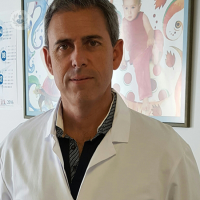early diagnosis of hip dysplasia in children
Written by:The development of hip dysplasia in children is an alteration of the shape of the hip that may be present at birth or develop during the first year. Early diagnosis is essential, because the treatment becomes more aggressive the higher the child. However, if diagnosed before 6 months, the rate of successful treatment is high.
Development of hip dysplasia: what is and generates
Developmental dysplasia of the hip is one of the pathologies characteristics of orthopedics and child Traumatology. Over the years he has received several names, most frequently congenital hip dislocation. However, as the problem is not always present at birth but may appear later with varying degrees of alteration of the hip without reaching the dislocation, the most appropriate name is that of developmental dysplasia of the hip.
 It is an altered form of the hip that may be present at birth (most often) or go producing as the child grows, usually during the first year of life. As a result of this alteration of the femoral head shape you can end up going off of your site. In less severe cases you can reach adulthood with inadequate shape of the hip which will lead to a deterioration of the joint, with the passage of time and the development of osteoarthritis. For these reasons it is very important to make a diagnosis as early as possible because the sooner treatment is started it is easier and more chances of success.
It is an altered form of the hip that may be present at birth (most often) or go producing as the child grows, usually during the first year of life. As a result of this alteration of the femoral head shape you can end up going off of your site. In less severe cases you can reach adulthood with inadequate shape of the hip which will lead to a deterioration of the joint, with the passage of time and the development of osteoarthritis. For these reasons it is very important to make a diagnosis as early as possible because the sooner treatment is started it is easier and more chances of success.
In our society this condition is not usually related to incorrect attitudes in handling babies. Hip dysplasia is more common in cultures that surround infants with both legs together, something unusual in our society. The baby carriers, which hold the opposite view with open hips, have not been linked to an increased risk of developing hip dysplasia.
Diagnose developmental dysplasia of the hip in children
It is essential for diagnosis exploring hips in all newborns performing a series of maneuvers that tell us whether the hip out of place or is dislocated. These scans should be repeated in all baby health checks, at least until it meets the year, since the problem does not appear at birth. After three months the sign that should make us suspect that may be dislocated hip is the limitation of abduction, ie the affected hip does not open as healthy.
When the scan is abnormal ultrasound should be performed to confirm the hips and assess the severity of dysplasia, with an X-ray after six months. direct family history of dysplasia, breech presentation in the third trimester of pregnancy, congenital muscular torticollis, disorders: ultrasound (made around 6 weeks) in babies with normal scan presenting some of those who call risk factors is also performed lower limbs, among others.
Treatment of developmental dysplasia of the hip in children
If hip dysplasia is diagnosed early treatment is relatively simple. There are different orthotics for treatment: the Pavlik harness is the most widely used device and has a success rate of 95%. The usage time depends on the severity of dysplasia and months of life the child has to start treatment, but the average is usually three months.
In cases where the harness is not effective (usually because there is some structure that leaves the femoral head into your site) treatment and becomes more complex. One must resort to a closed reduction, which means reducing the hip under general anesthesia, and placement of a hip spica to keep it in place for at least 12 weeks. And, in some cases, open reduction, consisting of an operation is necessary.
Treatments become more aggressive as higher the child. Hence the importance of early diagnosis. If diagnosed after six months, it is more likely to have to resort to the last mentioned treatments.
Rarely hip does not acquire the right way despite previous treatments, or do not follow proper development after them, so you always have to control the development of the hips. Sometimes some surgeries throughout the child's growth are necessary to change that inappropriately.
Edited by Roser Berner Ubasos.


